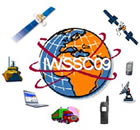International Workshop on Satellite and Space Communications (IWSSC 2009)
10th-11th September 2009, Siena-Tuscany, Italy
for info, email to: iswcs09@dii.unisi.it
This workshop will be co-located with ISWCS 2009; for more details please visit the ISWCS 2009 Web page at the URL: http://www.iswcs.org/iswcs2009/

IWSSC 2009 Tutorials, September 9, 2009 (anticipated of one day due to high number of paper presentations!)
Organized by Anton Donner, DLR, Germany
T1: "A Suitable Protocol Stack for Space Communications: the CCSDS Suite"
presented by Tomaso de Cola, DLR, Germany
14h00-15h30
Abstract: The Consultative Committee for Space Data Systems (CCSDS) is a standardisation body composed of worldwide space agencies, involved in the definition of protocols for effective data communications over space networks. A full protocol stack including specifications from the physical up to the application layers has been defined and continuously refined and re-elaborated over the years according to the requirements of various space missions. Being space exploration a key-topic in current satellite community, this tutorial is intended to give an overview of the main protocols currently available from CCSDS and their interoperability with legacy suites such as TCP-IP.
T2: "DVB-S2/RCS Enhanced for Mobile Applications"
presented by Stefano Cioni (Authors: S. Cioni, G. E. Corazza, A. Vanelli-Coralli), University of Bologna, Italy
14h00-15h30
Abstract: The DVB-RCS standard has been recently extended to cover mobile scenarios for airplane, maritime, railways, and vehicular applications. These challenging mobile propagation environments along with the regulatory constraints called for the introduction of new transmission modes both at physical and upper layers. Moreover, the target scenarios required also the introduction of a forward link able to deal with mobility issues. To this aim, an augmented version of the DVB-S2 standard has been designed and included thus providing an efficient DVB-RCS/S2 bundle now known and standardized as DVB-RCS+M. This tutorial will dwell on this standard providing a deep understanding of the rationale behind the standard design and its performance. Starting from the characterization of the mobile environment targeted by the DVB-RCS+M standard, the Course will cover both physical layer techniques able to cope with the challenging mobile propagation channel and upper-layer solutions introduced to improve the service continuity and robustness to long fading events. Finally, the tutorial will also take the chance to discover the preliminary advanced solutions for the second generation of the DVB-RCS standard, which is currently under specification.
T3: "Managing Aeronautical Telecommunication: a Role for Satellite?"
presented by Christian Kissling, DLR, Germnay
16h00-17h30
Abstract: The continuous and significant growth in aircraft passenger demand, especially in Europe and the U.S., is expected to exceed the capacity limitations of current Air Traffic Management (ATM) communication systems around 2020 and possibly even earlier. A new Air Traffic Management communications infrastructure is thus required for the future. Satellite communication links can be a central component of this infrastructure and can complement terrestrial communication links to provide in sum the needed capacity and service levels. The design of a seamless network architecture which integrates these different and heterogeneous links into a seamless network is thus of high importance and has to deal with many different aspects, especially with respect to provision of mobility, security and the provision of Quality of Service. In contrast to regular, terrestrial Internet applications, the operational ATM data traffic has strict requirements, e.g. regarding maximum latencies, availability and integrity which have to be fulfilled. This tutorial aims to provide an introduction of the aeronautical communication scenario, its particularities and to show possibilities how satellite communication links can be integrated in the overall network architecture. Moreover, approaches with respect to the technical issues to manage mobility, safety and security and QoS in this particular environment are presented.
T4: "Satellite Network Security and Related Research Issues"
presented by Haitham Cruickshank, UNiversity of Surrey, UK
16h00-17h30
Abstract: Satellite network security has become a hot research topic in recent years due to the closer integration of satellite and IP networks and due to the wider choice of applications and services that run over satellite networks. This tutorial will give an overview of the security threats and requirements in satellite networks. Also it gives some specific security systems such as DVB-S, DVB-RCS, ULE and IPsec over satellites. The tutorial will also focus on the open research issue in satellite networks such key management, secure multicasting, identity hiding and DTN related key management.
Only for conference registered participants: If you want to download the tutorials slides in pdf, please ask for credentials at the registration desk and then click HERE
